
Want to learn more? This National Geographic Book on Owls is a great read!
The Northern Saw-whet Owl is the owl with the highest number of recorded sightings and is therefore the one you are most likely to see in the state of Maine.
Maine is a state in the north east of the US and is well known for being the frequent setting of horror novels written by Stephen King.
This state has a varied climate which means that it has hot summers and cold winters.
Across the state of Maine there are 32 different state parks and there are 4 different national parks throughout the state.
Now that we’ve had a look at the different species of owls that have been confirmed to reside in Maine, let’s look at the individuals in more detail and find out when and where you can see them.
Want to attract Owls to your yard? Take a look at our article!
What Owls can be seen in Maine?
Table of Contents
1. Eastern Screech Owl
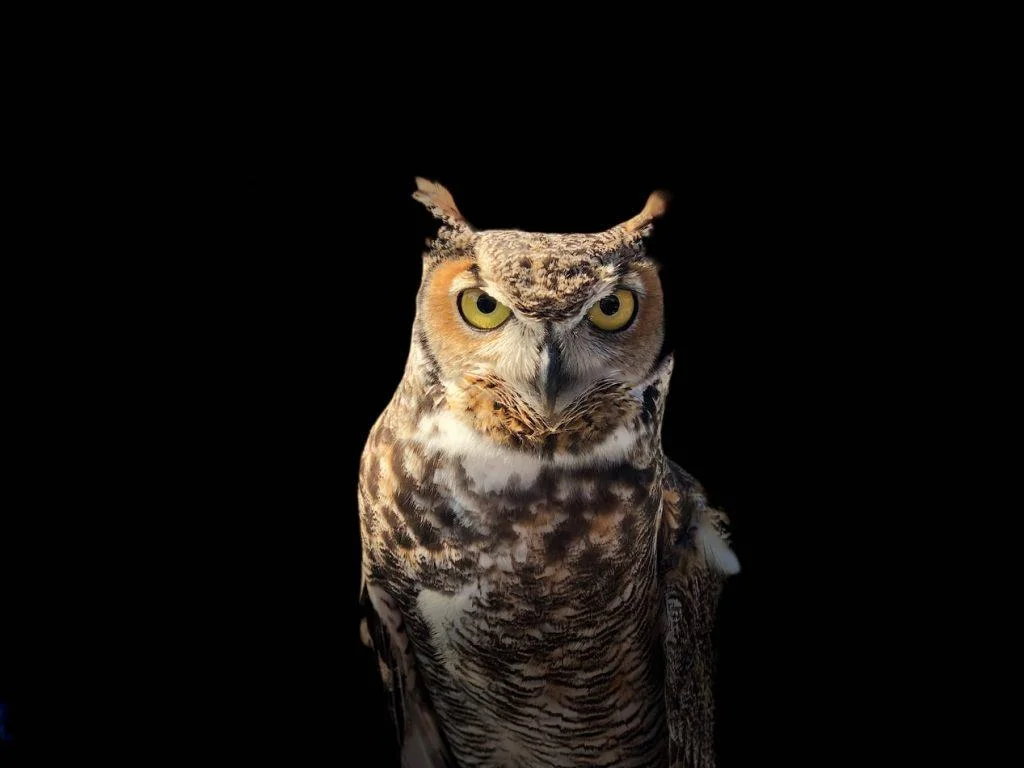
Wingspan
46 to 61 cm
Weight
160 g
Life Expectancy
14 years
Diet
Rats, Squirrels, Rabbits & Skunks
The Eastern Screech-Owl has a small stocky body and grey feathers and they look very similar to the Western Screech-Owl.
Males are believed to mate with several females during the breeding season, but they will form a pairing with one individual to help them raise the brood.
These pairings are also not a long-term thing and will change every year. Females will stay in the nest and incubate the eggs whilst males spend most of their time defending their territory.
These birds have adapted well to suburban areas and have successfully bred in city parks and farmland.
They also appear happy to use manmade bird boxes, although they prefer to stay in dense forest areas.
These owls are permanent residents in the state of Maine and can be seen throughout all areas of the state.
They are most active during their breeding seasons and the highest density of sightings have been recorded in the southern half of the state.
2. Great Horned Owl

Wingspan
~140cm
Weight
1.4 kg
Life Expectancy
28 years old
Diet
Squirrels, Rabbits & Skunks
The Great Horned Owl has long, and sharp looking ear tufts and it is medium in size for a species of owl.
These ear tufts resemble the horns mentioned in its name, which is where it comes from. These owls can breed and nest successfully in suburban areas such as city parks but, you are most likely to see them in areas of denser woodlands.
Once a breeding pair is formed, both individuals will help to protect the nest as both males and females of this species are territorial.
Their aggression has known to be extended as far as killing other members of their own species.
The breeding pairs are long lasting, and they will both remain in their territory outside of the breeding season; however, they will roost separately.
These owls are permanent residents in the state of Maine so they can be seen year-round and seen throughout all regions of the state.
Most of the sightings of this owl have been in the southern half of the state whilst there are less in the northern half of Maine.
3. Northern Saw-whet Owl
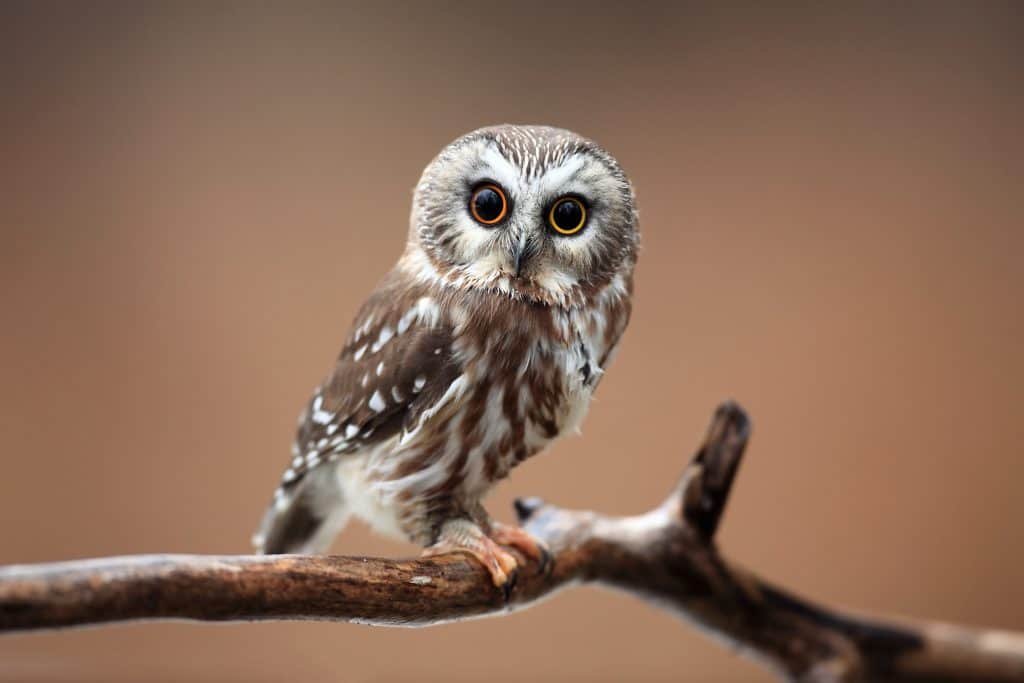
Wingspan
40 - 60 cm
Weight
100 g
Life Expectancy
7 years
Diet
Small birds, young squirrels, voles & shrews
The Northern Saw-Whet Owl is very small in size for an owl and it has a big round head and wide orange eyes.
The feathers that cover their wings and back come in various shades of brown whilst the feathers on their bellies are bright white.
These birds will only nest in particularly dense woodland areas and will stay in more mature forests where they can.
When it comes to the winter and breeding seasons, the density of the forest is much more crucial.
Whilst most males are completely monogamous, in seasons of high prey abundance, some males have been known to mate with another individual.
This appears to be the only thing that affects the monogamy of this owl. However, breeding pairs are not long term and most owls will find new mates in subsequent breeding seasons.
Because of their small size, these owls are also often preyed on by a variety of larger owl species, including several that we have previously looked at in this article.
These birds are migratory but they are usually year-round residents in the state of Maine and they can be seen throughout all of the regions in the state.
They are most active during their breeding seasons and the highest recorded number of sightings have been in the southern regions, particularly along the coast whilst the lowest number of sightings have been in the northern regions of Maine.
4. Short-Eared Owl
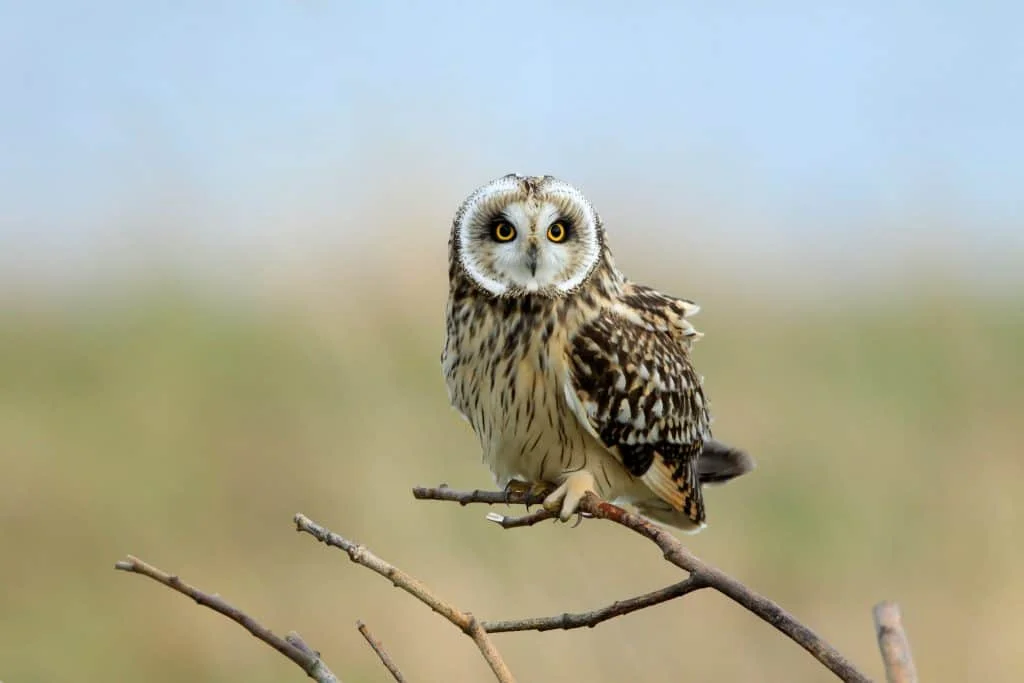
Wingspan
85 to 110 cm
Weight
206–475 g
Life Expectancy
4-12 years
Diet
Voles, Mice, Squirrels
This owl has tiny ear tufts that can barely be seen which is why it is known as the Short-eared Owl.
These owls are a medium sized owl species and they have brown feathers spotted with buff that cover all of their bodies.
You are most likely to see this owl in large areas of open grasslands. Their activity changes depending on the season and they tend to be active at all hours of the day and night when it reaches the breeding season.
They will spend a lot of the daytime doing courting displays for females so will use the night to do some extra hunting.
After mating, the males will not do much to help raise the young, but he will protect the female whilst she stays in the nest to incubate the eggs.
The males will protect the female by performing distraction displays to intruding individuals to deter them away from their nesting site and this is often done to animals of much bigger size.
Whilst these birds have a range that means they can be seen in all areas of the state.
That being said, they are not permanent residents of the state and can only be seen in Maine outside of their breeding seasons.
Most of the sightings of this bird have been in the south western areas of the state.
5. Snowy Owl
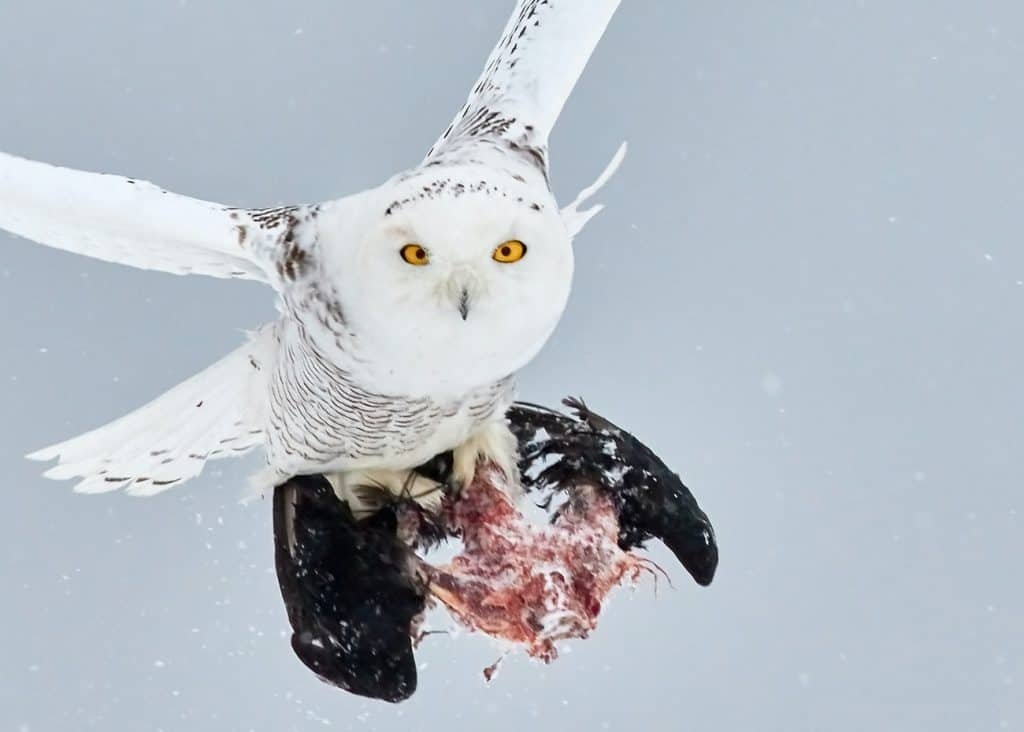
Wingspan
150 cm
Weight
2 kg
Life Expectancy
10 years
Diet
Birds, Rabbits, Fish & Rodents
The Snowy Owl is much more common in arctic areas rather than in the United States and usually stays in Canada, but it will stray into northern states during winter months.
Its body is covered in bright white feathers that help it camouflage against the snow in its tundra habitat.
The male has a complex courtship display that he does for a female which involves diving flights and at the end of the display the male will drop a lemming, or another item of prey, next to the female as a gift to her.
These owls are very territorial and can be very aggressive to anyone trying to enter their habitat.
There have been recorded incidents of pairs attacking an arctic wolf as well as dive bombing humans that move too close to their habitats.
You can only see these owls in the state of Maine during the colder winter seasons when they move further south.
They have been seen in all areas of the state but they have most commonly been sighted along the coast of the state whilst the least sightings have been in the central regions of the state.
6. Long Eared Owl
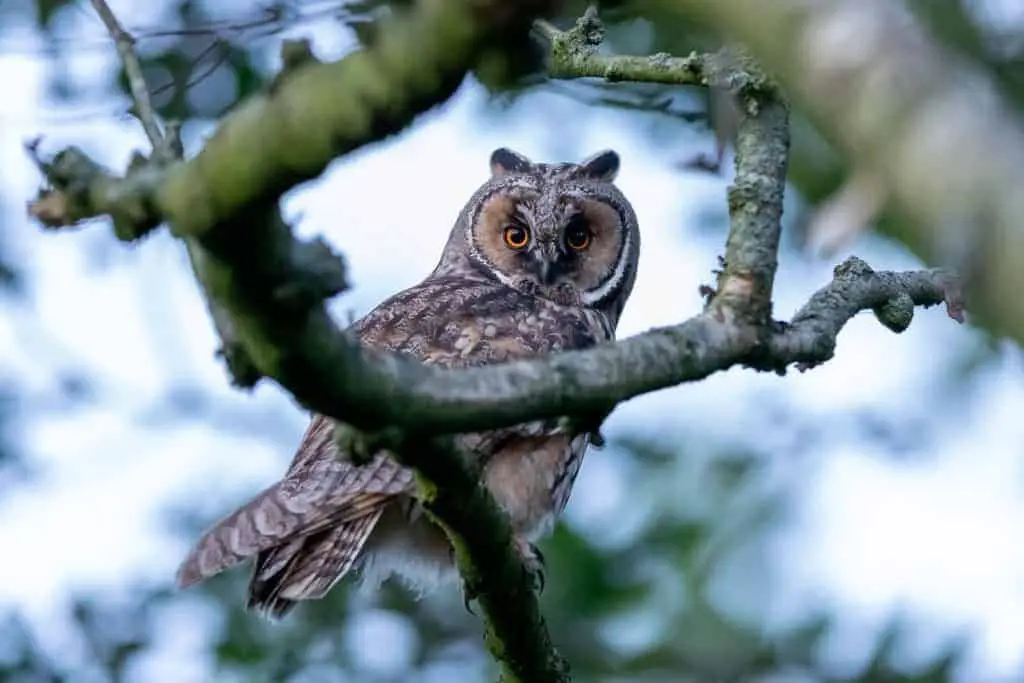
Wingspan
90 to 100cm
Weight
250 g
Life Expectancy
4 years
Diet
Small mammals, mice, rats & rabbits
The Long-Eared Owl has long and prominent feathered ears, which is unsurprisingly where it gets its name from.
They have black and brown feathers that cover their bodies and their faces are orange.
These owls like to roost in dense woodlands when they are breeding. outside of the breeding season will roost in loose colonies of up to 100 individuals.
During the breeding season these colonies will nest near each other, but they will not roost together.
These birds form breeding pairs and remain monogamous during the mating season. That being said, it is unknown as to whether these breeding pairs are long term or if they form different breeding pairs each year.
Males will court the females by performing a series of complex, zigzag flights whilst producing a mating call.
These birds are not often permanent residents in the state and are most commonly seen in the months outside of their breeding seasons.
They can be seen throughout all regions of the state and the most common area for recorded sightings is in the eastern half of the state.
7. Northern Hawk Owl
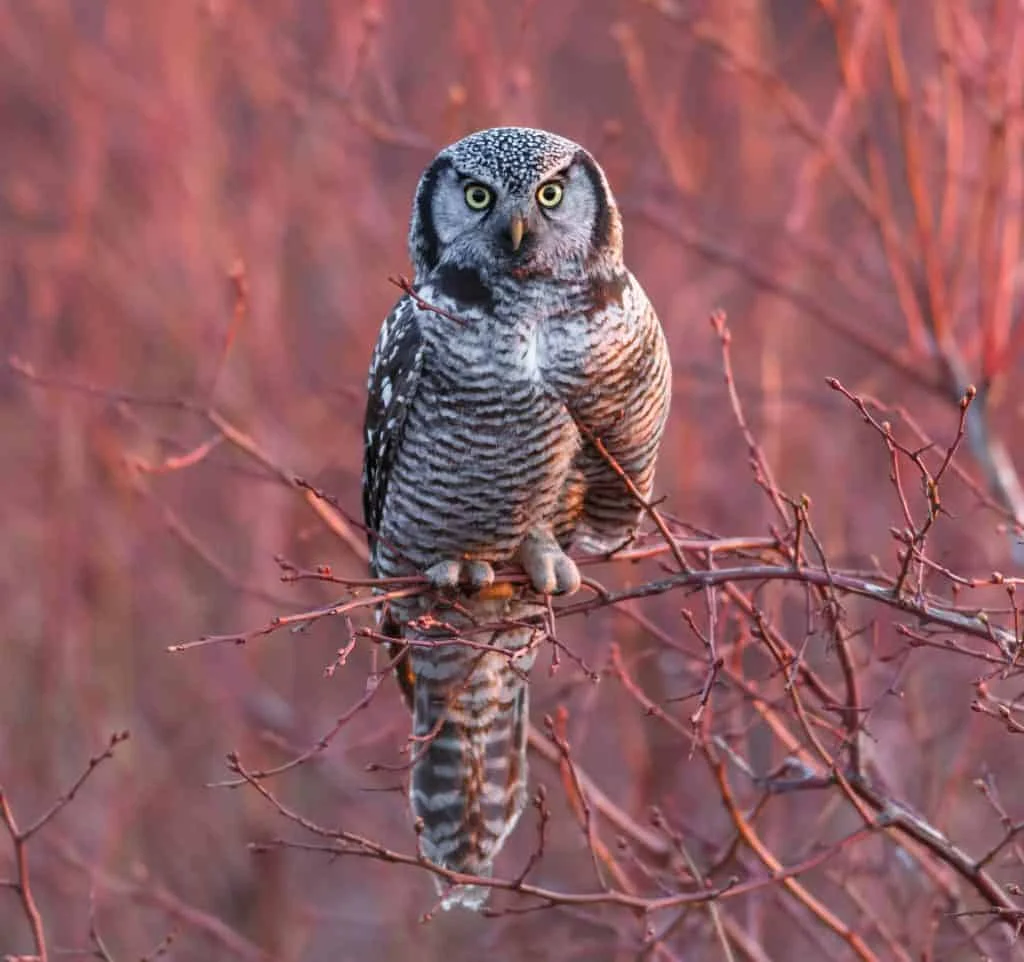
Wingspan
45 cm
Weight
300 -340 g
Life Expectancy
Up to 16 years
Diet
Rodents & Small Mammals
The Northern Hawk owl is medium in size, their body is covered in brown feathers whilst they have a white and grey face.
You are most likely to see these birds in coniferous forests, usually in more open woodland areas.
Unlike a lot of owls, Northern Hawk Owls hunt mostly during the daytime.
These birds are mostly solitary and breeding pairs only seem to last for one season, these birds also appear to be monogamous.
These birds are not permanent nor common residents of the state of Maine.
They can only be seen during the wintering seasons when they migrate south to deal with the colder months.
Their range only extends to the northern half of the state with the most common number of sightings being recorded in the central area.
8. Great Grey Owl
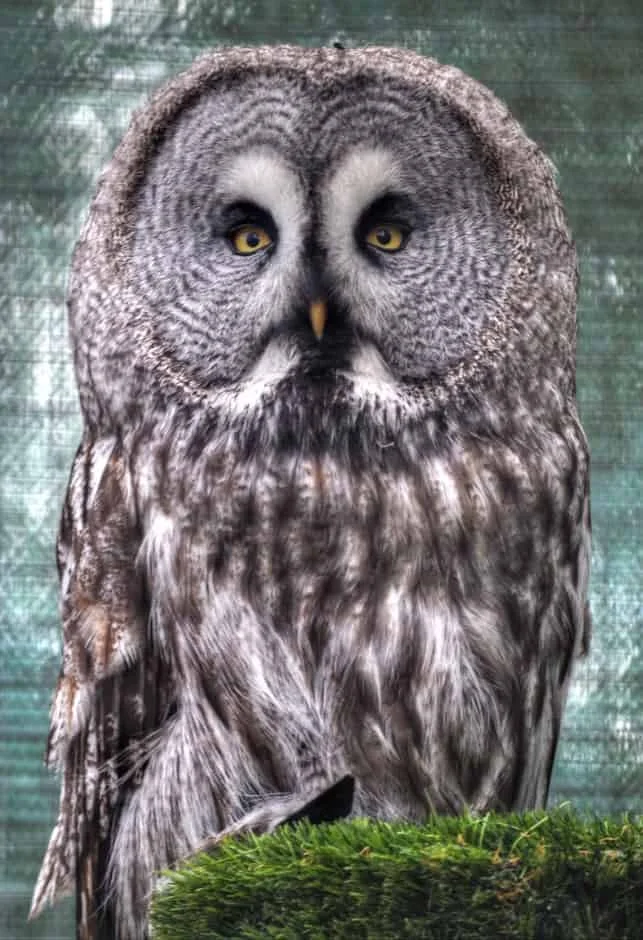
Wingspan
Up to 152cm
Weight
1.1 kg
Life Expectancy
12 years old
Diet
90% small rodents
These birds are one of the tallest species of owls to exist.
As you can expect from the name, these owls are mostly a silvery grey colour, but they can vary in shades including brown feathers.
You are most likely to see one of these owls in meadow areas which is where they primarily hunt.
These owls are most likely to hunt during the day when they have nestlings or during the winter months when prey is less abundant.
It appears as though Great Grey Owls form monogamous and long-term breeding pairs, but the individuals do not stay close to one another outside of the breeding seasons.
These owls are not permanent residents of Maine and can only be seen outside of their breeding seasons, most commonly in the winter months.
Their range extends to the state and the highest number of recorded sightings have been in the northern regions of the state.
9. Barred Owl
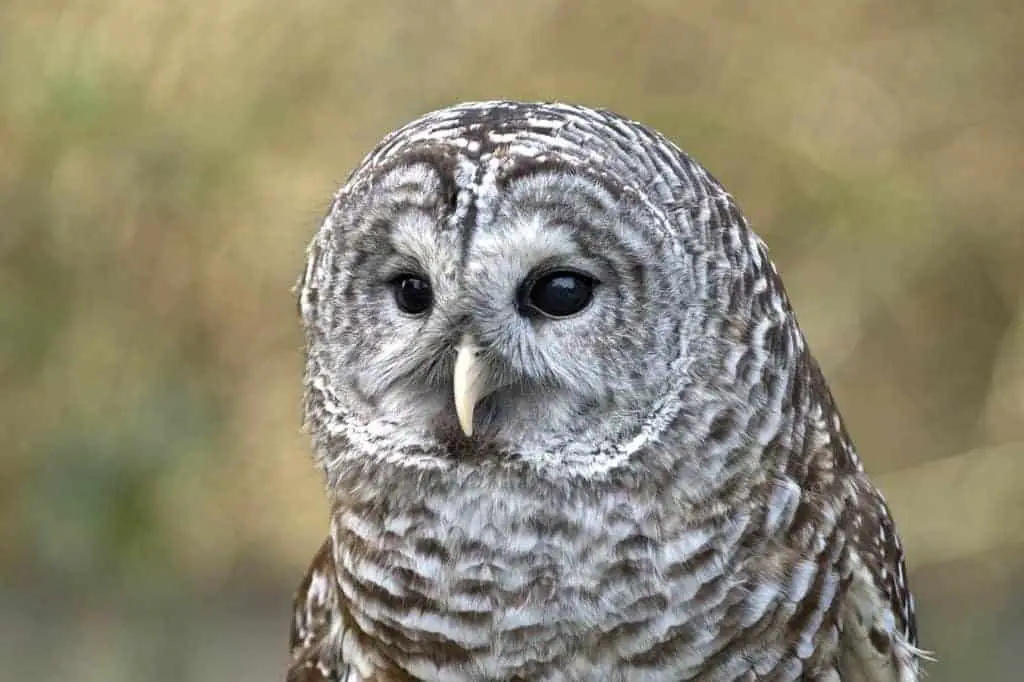
Wingspan
96-125 cm
Weight
468-1,150 g
Life Expectancy
10-23 years
Diet
Small mammals
The Barred Owl is covered in bars of brown and white on its wings that are made by its feathers.
These bars are where the owl gets its name as well helping it to camouflage against trees.
They like to stay in woods that are close to swamps and marshlands and can be found in a variety of mixed woodland areas.
These owls hunt at night and spend their day roosting which is common for a lot of owl species.
Both individuals in the breeding pair are defensive of their territory and remain monogamous to each other.
It is thought that these breeding pairs are long term and they are thought to mate for life although this is not fully confirmed.
These owls are non-migratory so most will stay in a single area within the state of Maine and they can be seen year-round.
Their ranges encompasses all areas of the state but most of the sightings have been in the north east of the state whilst the least amount of sightings have been to the north west of the state.

More Articles.

How To Attract Birds To A Balcony?
The best way to attract birds to a your balcony is to choose the correct
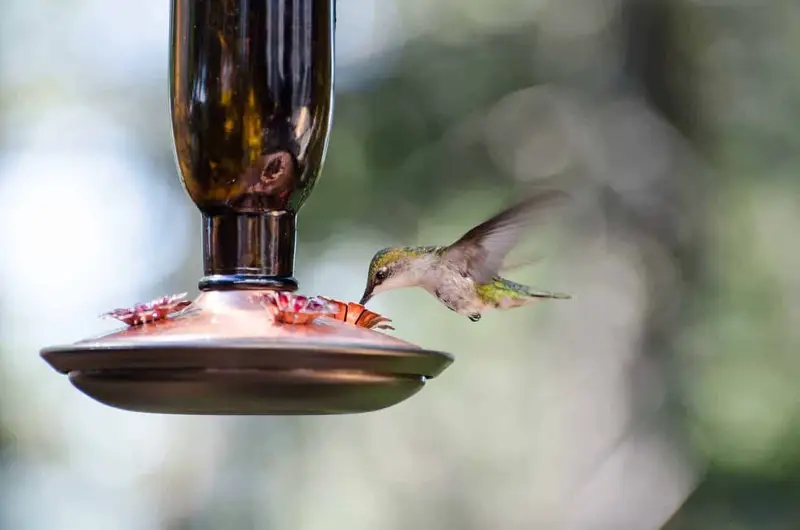
Best Hummingbird Feeders for 2020
Nectar bird feeders are well-known for attracting a variety of adorable birds and for saving
How to Attract Cardinals to Your Backyard: 7 Proven Tips
Attracting cardinals to your backyard is simple when you focus on their needs: food, water,

About Us
We are avid bird-watchers who recently retired, allowing us more time to travel the world. Fortunately, we have managed to visit numerous countries around Europe, Asia, and America. Watching and photographing birds has been a passion for many years and we are making the most of the extra time on our hands!
